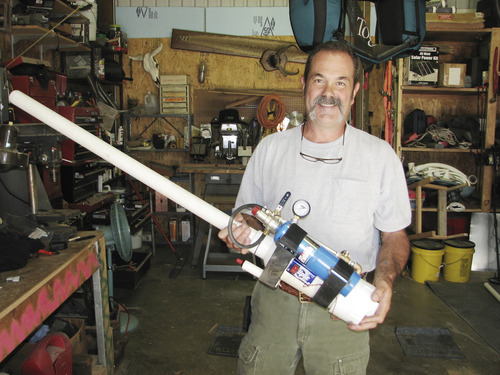This is an archived article that was published on sltrib.com in 2011, and information in the article may be outdated. It is provided only for personal research purposes and may not be reprinted.
Last week, Sonny and I finally perfected our potato cannon design in his garage. Not only does the thing work the way it was intended, but nobody got hurt bad enough to call an ambulance.
The gun itself was the easy part. Some PVC pipe, batteries, a bit of wire, a barbecue igniter switch, and a few squirts of propane were all we needed to build something serious.
We tested it. I am proud to report that, given sufficient provocation, we could shoot a potato clear through Oprah Winfrey.
We didn't actually do this, of course. That would be illegal, possibly even a felony. But during field trials we did put some ginormous dents in Sonny's storage shed, chicken coop, two fences and my truck. The last one was partially (61 percent) an accident.
Potato cannons are not difficult to build. Plans are available on various lunatic websites. Just Google "spud guns" and see.
Once the gun was built, getting it to fire on command turned out to be the tricky part. A scientifically precise ratio of propane and oxygen is necessary for ignition. Too much or not enough gas and nothing happens.
Because of our personalities, it's almost impossible for Sonny or myself to follow any sort of direction, especially if it involves serious egghead math.
I can do single-digit arithmetic, and Sonny can do his multiplication tables up to four. Beyond that, we have to guess. So, the fuel-ratio instructions we downloaded did us little good.
Here is an actual quote: "Multiply 14.7*6.35 to get 93.345 then divide this figure to get the required meter volume of 1.037 cubic inches."
Sonny spoke for backyard gunners everywhere when he said, "What the &*$@ does that mean?"
After two hours of trial and error, we came up with a formula of our own. Here it is: "Ventilate tube, four medium squirts of propane, cover good eye, pull trigger."
The first spud left the gun with a disappointing THUNK! Nevertheless, it ripped through the branches of a tree and disappeared into a neighborhood 150 yards away. We listened. A dog barked, but no screams or sirens.
Just to be safe, we decided that ours was an anti-aircraft potato gun. Shooting the gun straight into the air meant that everything would come straight back down.
Potatoes work best for this. They're easier to monitor against a blue sky than, oh, say, a blue golf ball. And unless you want a head that looks like a bird bath, you'll keep that in mind.
Our first shot at the sky nearly put a potato into orbit. Coming back down, the potato fairly glowed from the speed of re-entry. It hit the ground with a heavy thump that smartened us right up.
Just because it's called a spud gun doesn't mean you have to stick with potatoes for ammunition. We also fired apples, a cucumber, some marigolds, a T-shirt, a bratwurst and a rolled-up Reader's Digest.
Shooting a handful of fish sinkers wrapped in a paper towel will put a hole in a wooden fence through which you might then be able to launch a raccoon. Do not do this.
IMPORTANT: This is the disclaimer part. Our wives insisted that we tell everyone that a potato gun is not a toy. It should never be fired in a quiet neighborhood.
Next week, Sonny and I are taking the spud gun on a road trip to New Mexico. It's probably safer to shoot it at a completely foreign country like Texas.
Robert Kirby can be reached at rkirby@sltrib.com or facebook.com/notpatbagley.



